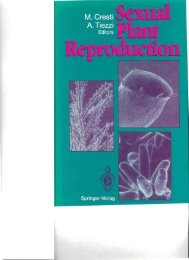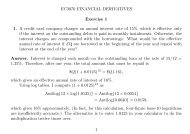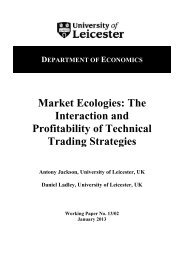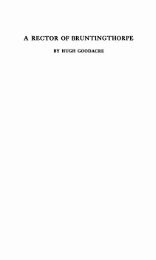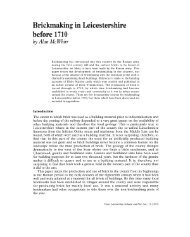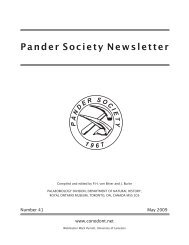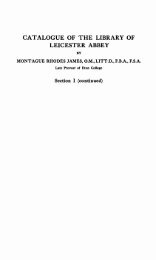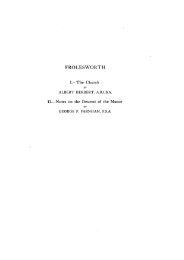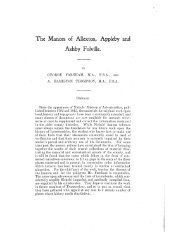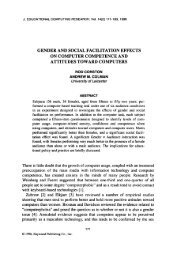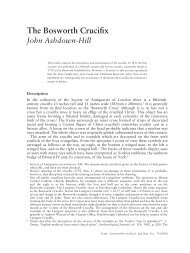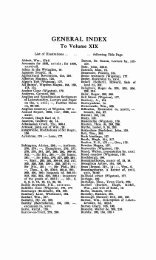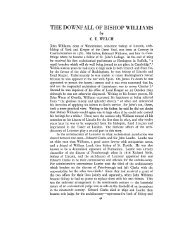Page Toys and Games: An Oral History - University of Leicester
Page Toys and Games: An Oral History - University of Leicester
Page Toys and Games: An Oral History - University of Leicester
You also want an ePaper? Increase the reach of your titles
YUMPU automatically turns print PDFs into web optimized ePapers that Google loves.
<strong>Toys</strong> <strong>and</strong> <strong>Games</strong>: <strong>An</strong> <strong>Oral</strong> <strong>History</strong><br />
<strong>Page</strong><br />
1
The East Midl<strong>and</strong>s <strong>Oral</strong> <strong>History</strong> Archive<br />
<strong>Toys</strong> <strong>and</strong> <strong>Games</strong>: <strong>An</strong> <strong>Oral</strong> <strong>History</strong><br />
The East Midl<strong>and</strong>s <strong>Oral</strong> <strong>History</strong> Archive is a partnership between the Centre for<br />
Urban <strong>History</strong> at the <strong>University</strong> <strong>of</strong> <strong>Leicester</strong>, the Record Office for <strong>Leicester</strong>shire,<br />
<strong>Leicester</strong> <strong>and</strong> Rutl<strong>and</strong> (ROLLR), <strong>and</strong> <strong>Leicester</strong> City Museums <strong>and</strong> Library Services.<br />
It is funded by the Heritage Lottery Fund to establish the first large-scale archive <strong>of</strong><br />
oral history recordings for <strong>Leicester</strong>shire <strong>and</strong> Rutl<strong>and</strong>.<br />
Its first aim is to retrieve as many existing recordings as possible, <strong>and</strong> to then make<br />
them accessible through a website, an on-line catalogue, newsletters <strong>and</strong> edited CDs<br />
<strong>and</strong> cassettes. In addition to the Record Office itself, some <strong>of</strong> the recordings will also<br />
be available in libraries <strong>and</strong> museums. EMOHA also aims to generate new oral<br />
history recordings through its own programme <strong>of</strong> interviewing, <strong>and</strong> by providing<br />
advice, training <strong>and</strong> support for community groups, museums <strong>and</strong> heritage<br />
organisations, students <strong>and</strong> other individuals who are interested in developing their<br />
own projects.<br />
East Midl<strong>and</strong>s <strong>Oral</strong> <strong>History</strong> Archive<br />
Centre for Urban <strong>History</strong><br />
<strong>University</strong> <strong>of</strong> <strong>Leicester</strong><br />
LE1 7RH<br />
emoha@le.ac.uk<br />
Fax: (0116) 252 5769<br />
Phone: (0116) 252 5065<br />
<strong>Page</strong><br />
3
East Midl<strong>and</strong>s <strong>Oral</strong> <strong>History</strong> Archive<br />
<strong>Page</strong><br />
4<br />
Published by the <strong>University</strong> <strong>of</strong> <strong>Leicester</strong> 2002<br />
<strong>University</strong> Road, <strong>Leicester</strong>, LE1 7RH<br />
Copyright © East Midl<strong>and</strong>s <strong>Oral</strong> <strong>History</strong> Archive 2002<br />
Sections <strong>of</strong> this book <strong>and</strong> CD may be reproduced for educational<br />
purposes on the condition that the East Midl<strong>and</strong>s <strong>Oral</strong> <strong>History</strong> Archive is<br />
acknowledged as the author.<br />
Produced by the East Midl<strong>and</strong>s <strong>Oral</strong> <strong>History</strong> Archive at the <strong>University</strong> <strong>of</strong><br />
<strong>Leicester</strong> 2002.<br />
ISBN 1 898489 28 9
<strong>Toys</strong> <strong>and</strong> <strong>Games</strong>: <strong>An</strong> <strong>Oral</strong> <strong>History</strong><br />
<strong>Toys</strong> <strong>and</strong> <strong>Games</strong><br />
<strong>An</strong> <strong>Oral</strong> <strong>History</strong><br />
Sarah Ferrier<br />
<strong>and</strong> Tristram Hooley<br />
Editors<br />
East Midl<strong>and</strong>s <strong>Oral</strong> <strong>History</strong> Archive<br />
<strong>Page</strong><br />
5
East Midl<strong>and</strong>s <strong>Oral</strong> <strong>History</strong> Archive<br />
Contents<br />
Introduction 5<br />
The Changing Context <strong>of</strong> Childhood 6<br />
Track Listings 8<br />
Links to <strong>History</strong> Curriculum <strong>and</strong> Scheme <strong>of</strong> Work 12<br />
Cross-curricular Links 13<br />
Activities 15<br />
Transcripts 21<br />
The <strong>Games</strong> Children Played 26<br />
<strong>Oral</strong> <strong>History</strong>: The Next Generation 28<br />
Bibliography <strong>and</strong> Resources 30<br />
Photos 33<br />
<strong>Page</strong><br />
6
Introduction<br />
<strong>Toys</strong> <strong>and</strong> <strong>Games</strong>: <strong>An</strong> <strong>Oral</strong> <strong>History</strong><br />
The resources in this book <strong>and</strong> CD are intended to help children think about the toys <strong>and</strong> games<br />
that their parents <strong>and</strong> gr<strong>and</strong>parents played with when they were children, <strong>and</strong> those that they play<br />
with themselves. The earliest memories on the CD were recorded during the 1980s <strong>and</strong> are<br />
predominantly male because they were collected for projects which focused on traditional<br />
workplaces. Later memories are recorded specifically for the purpose <strong>of</strong> this collection <strong>and</strong> so<br />
cover a broader range <strong>of</strong> interviewees <strong>and</strong> experiences.<br />
This collection comprises a wealth <strong>of</strong> childhood memories, from tales <strong>of</strong> mischief <strong>and</strong> adventurous<br />
play <strong>and</strong> days when toys were a luxury, to crazes like Action Man, hula hoops <strong>and</strong> computer games.<br />
Listeners will be able to identify with many aspects <strong>of</strong> these <strong>and</strong> may be surprised to find that,<br />
despite apparent changes in childhood since the early twentieth century, they also share many <strong>of</strong><br />
the speakers’ experiences.<br />
Acknowledgements<br />
The East Midl<strong>and</strong>s <strong>Oral</strong> <strong>History</strong> Archive would like to thank Albert Attenborough, Cynthia<br />
Brown, Elijah Burton, Brenda Clark, Ray Culley, Lucy Faire, Selina Mary Gee, Lesley Gill, Korin<br />
Grant, Elizabeth Halford, Bharti Harji, Maurice Harper, John Hooley, John <strong>and</strong> Mary Howlett,<br />
Eric Hunt, Colin Hyde, Rob James, Mark Jones, Jamie Knox, Doris Langham, Jenny Lucas, M<strong>and</strong>y<br />
Morris, C Robinson, Richard Rodger, Iris Smith, Claire Speller, Bharti Thakrar, Christine Thornhill,<br />
Clare Williamson, Arthur Winfield, Wilfred Winfield, Simeon Woolley, the children <strong>and</strong> staff <strong>of</strong><br />
Shaftesbury Junior School, <strong>and</strong> everyone else who has contributed to the making <strong>of</strong> this resource.<br />
<strong>Page</strong><br />
7
East Midl<strong>and</strong>s <strong>Oral</strong> <strong>History</strong> Archive<br />
As We Played: the Changing Context <strong>of</strong> Childhood<br />
What sort <strong>of</strong> things have influenced the nature <strong>of</strong> children’s play during the period covered by this<br />
CD?<br />
Organised games became increasingly popular from the later 19 th century, both in schools <strong>and</strong> in<br />
churches, chapels <strong>and</strong> other organisations which ran activities for young people. Like the drill<br />
taught in schools, they were designed to instil discipline, promote physical fitness, <strong>and</strong> encourage a<br />
sense <strong>of</strong> ‘team spirit’ – qualities regarded as increasingly desirable in the context <strong>of</strong> anxieties about<br />
the ‘delinquency’ <strong>of</strong> the young, <strong>and</strong> the longer-term survival <strong>of</strong> Britain <strong>and</strong> its Empire.<br />
However, most <strong>of</strong> the games recalled on this CD fall outside this world <strong>of</strong> adult control <strong>and</strong><br />
supervision. They are testimony to the ingenuity, imagination <strong>and</strong> spontaneity <strong>of</strong> children who<br />
<strong>of</strong>ten had little in the way <strong>of</strong> ‘formal’ play equipment – <strong>and</strong> to the oral tradition through which the<br />
complex rules by which games are played are guarded <strong>and</strong> passed on. It was the children<br />
themselves who enforced these rules, <strong>and</strong> who were also responsible for deciding - through<br />
personal preference, the formula <strong>of</strong> a rhyme or ‘dib’, or on the grounds <strong>of</strong> gender alone - who<br />
might be allowed to play. It was the children, too, or their chosen ‘Captain’, who devised the tactics<br />
designed to ‘see <strong>of</strong>f’ the opposition.<br />
It is <strong>of</strong>ten said – <strong>and</strong> repeated in several extracts on the CD – that children were safer in the past<br />
than they are today. Certainly the fear <strong>of</strong> assault or abduction was less than it is today. Such<br />
incidents may have been less widely reported, but it is debatable if they were quite so rare as is<br />
assumed. The assumption that rural areas provided safer ‘playgrounds’ than the towns is also worth<br />
reconsidering. The seemingly innocuous fields<br />
<strong>and</strong> woods <strong>of</strong> the countryside concealed a<br />
multitude <strong>of</strong> natural hazards such as bogs,<br />
streams, the legendary ‘bottomless’ pools <strong>and</strong><br />
pits, bulls <strong>and</strong> potentially deadly plants – to say<br />
nothing <strong>of</strong> the ‘dare-devil’ attractions <strong>of</strong>fered<br />
by railway lines <strong>and</strong> rural industrial sites such as<br />
mines <strong>and</strong> quarries.<br />
<strong>Page</strong><br />
8<br />
The urban child <strong>of</strong>ten had easy<br />
access to the countryside as well.<br />
Even after the extension <strong>of</strong> the<br />
Borough boundaries in 1936, few<br />
children in <strong>Leicester</strong> were more<br />
than a mile or two from open<br />
countryside, <strong>and</strong> thought little <strong>of</strong><br />
walking five or more miles a day<br />
to enjoy it. Working class families<br />
in both town <strong>and</strong> country were<br />
<strong>of</strong>ten large in number, <strong>and</strong> the<br />
desire to escape from cramped<br />
<strong>and</strong> overcrowded houses meant<br />
that – weather permitting –<br />
children spent much <strong>of</strong> their time<br />
out <strong>of</strong> doors. However, if more<br />
spacious <strong>and</strong> comfortable houses<br />
encouraged a trend towards
<strong>Toys</strong> <strong>and</strong> <strong>Games</strong>: <strong>An</strong> <strong>Oral</strong> <strong>History</strong><br />
home-based play, this was reinforced by the<br />
growing dominance <strong>of</strong> the motor car in the<br />
post-Second World War period, as urban<br />
streets ceased to be the safe haven for play <strong>of</strong><br />
so many childhood memories.<br />
As many <strong>of</strong> the extracts on the CD suggest, a<br />
lack <strong>of</strong> ‘formal’ equipment or shop-bought toys<br />
was no real hindrance to play. Children used<br />
whatever came to h<strong>and</strong> – sticks as cricket bats,<br />
rolled up paper or pigs’ bladders as footballs,<br />
fire hydrants or manhole covers as ‘goals’, dolls<br />
made <strong>of</strong> old socks or cotton scraps, skipping<br />
ropes made <strong>of</strong> old ropes or – in East Africa –<br />
sugar cane grass. Nevertheless, the relative<br />
affluence which many (but by no means all)<br />
working class families enjoyed from the 1950s<br />
has been a major influence on the nature <strong>of</strong><br />
their play.<br />
Even in the 19 th century there was no lack <strong>of</strong><br />
manufactured toys available to those with the<br />
means to buy them, <strong>and</strong> by the 1850s child<br />
labour itself was extensively employed in<br />
manufacturing ‘penny’ toys for the less well<br />
<strong>of</strong>f, largely made from paper <strong>and</strong> wood.<br />
Technological advances including clockwork<br />
mechanisms <strong>and</strong> hollow metal toys increased the range <strong>of</strong> what was available, while mass<br />
production techniques gradually brought down their price. During the 20 th century, new materials<br />
such as plastic became available, along with the wonders <strong>of</strong> the microchip in more recent decades –<br />
<strong>and</strong> new media for advertising toys, games <strong>and</strong> equipment to an audience which currently has a say<br />
in around £30 billion <strong>of</strong> spending in the UK each year. Like radio <strong>and</strong> television before them,<br />
computers have also encouraged more sedentary <strong>and</strong> possibly solitary pursuits.<br />
However, as the later extracts on the CD demonstrate, despite all the changes <strong>of</strong> the<br />
last century, <strong>and</strong> the undeniable ‘commercialisation’ <strong>of</strong> childhood in some respects,<br />
there still remains ample scope for imaginative <strong>and</strong> spontaneous play.<br />
Cynthia Brown<br />
Project Manager<br />
East Midl<strong>and</strong>s <strong>Oral</strong> <strong>History</strong> Archive<br />
June 2002<br />
<strong>Page</strong><br />
9
East Midl<strong>and</strong>s <strong>Oral</strong> <strong>History</strong> Archive<br />
Track Listings<br />
The CD which accompanies this book is made<br />
up <strong>of</strong> three sections that focus on different<br />
aspects <strong>of</strong> childhood:<br />
Playing Out<br />
<strong>Page</strong><br />
10<br />
•<br />
•<br />
•<br />
memories <strong>of</strong> children’s play<br />
Playing Out features<br />
outside <strong>of</strong> school. This<br />
includes playing alone <strong>and</strong><br />
with friends, as well as<br />
memories <strong>of</strong> dangerous play<br />
<strong>and</strong> mischief.<br />
Playground <strong>Games</strong> focuses<br />
on the games that children<br />
played at school.<br />
<strong>Toys</strong> includes memories <strong>of</strong><br />
toys that children enjoyed or<br />
dreamed about.<br />
1 Whips, tops <strong>and</strong> mischief. a) 2 Males,<br />
born 1905 & 1909: describe playing with<br />
whips <strong>and</strong> tops on roads, ‘Tin-a-Lurkey’,<br />
playing in Bushby in the late 1950s. Even a wheel<br />
Children<br />
could be a toy in the right h<strong>and</strong>s. As tracks 27—39<br />
barrow<br />
toys haven’t always been something that were bought in the<br />
show,<br />
In the past children <strong>of</strong>ten had to make their own fun.<br />
shops.<br />
bowling with hoops, <strong>and</strong> ‘Spirit Rapping’. b) Female, born 1902: describes making mischief<br />
by knocking on front doors.<br />
2 Tin-a-Lurkey. Male, born 1908: talks about playing ‘Tin-a-Lurkey’ <strong>and</strong> collecting balls from<br />
coconut shys at the annual wake to use for playing hockey <strong>and</strong> cricket.<br />
3 Sound Yer Holler. Male, born 1920: describes playing ‘Sound Yer Holler’, making a barrow<br />
<strong>and</strong> ‘making your own fun’.<br />
4 Tin-High-Hockey. Male, born 1917: describes playing ‘Tin-High-Hockey’<br />
outside <strong>and</strong> playing in a tank from the First World War. Talks about making his ‘own<br />
fun in those days’.<br />
5 Making Bows <strong>and</strong> Arrows. Male, born 1908: describes how children made<br />
their own fun; describes how to make bows <strong>and</strong> arrows, <strong>and</strong> kites from willow, <strong>and</strong><br />
shooting trout.<br />
6 Adventurous Play in the Colliery. Male, born 1920: describes adventurous<br />
play in the colliery, sliding down spoil heaps <strong>and</strong> igniting gun-powder from the powder<br />
sheds!<br />
7 Adventurous Play in the Quarry. Male, born 1932: describes games played<br />
with Second World War bomb cases, <strong>and</strong> escapades in the quarry.
play with hoops in Spinney Hill Park around 1900. Girls<br />
Girls<br />
generally have had wooden hoops while boys frequently<br />
would<br />
the faster <strong>and</strong> more dangerous metal versions. Reproduced<br />
wanted<br />
permission <strong>of</strong> the <strong>Leicester</strong> Mercury.<br />
by<br />
<strong>Toys</strong> <strong>and</strong> <strong>Games</strong>: <strong>An</strong> <strong>Oral</strong> <strong>History</strong><br />
8 Shrove Tuesday. a) Female, born<br />
1913: talks about seeing toys for sale in shop<br />
windows <strong>and</strong> the Shrove Tuesday tradition <strong>of</strong><br />
boys playing with whips <strong>and</strong> tops, <strong>and</strong> girls<br />
playing battledore <strong>and</strong> shuttlecock. b) Female,<br />
born 1902: talks about playing battledore <strong>and</strong><br />
shuttlecock on Shrove Tuesdays, marbles, <strong>and</strong><br />
skipping.<br />
9 Football. a) Male, born 1908: describes<br />
playing football with rolled up socks, or a<br />
freshly killed pig’s bladder. b) 2 Males, born<br />
1905 <strong>and</strong> 1909: describe playing football with a<br />
pig’s bladder.<br />
10 Ponies, Tennis <strong>and</strong> Cricket. Female,<br />
born 1919: describes having ponies <strong>and</strong><br />
walking in the winter, <strong>and</strong> tennis parties <strong>and</strong><br />
cricket in the summer. Talks about how, as a<br />
girl, she had to keep score, rather than play.<br />
11 Wartime <strong>Games</strong>. Female, born 1929:<br />
describes playing snobs, hopscotch, double<br />
ball, hide <strong>and</strong> seek, hoop <strong>and</strong> stick, playing<br />
with cigarette cards, <strong>and</strong> collecting comics<br />
during the Second World War.<br />
12 Girls <strong>and</strong> Boys. Female, born 1951: explains how girls <strong>and</strong> boys played different games;<br />
describes games played by girls: double & triple ball, skipping in the street <strong>and</strong> ‘French’<br />
skipping.<br />
13 Elastic <strong>and</strong> Poddy 1-2-3. Female, born 1964: describes games played in <strong>and</strong> out <strong>of</strong> school:<br />
‘French’ skipping, Poddy 1-2-3, <strong>and</strong> collecting conkers.<br />
14 Summer Holidays in <strong>Leicester</strong>. Female, born 1929: talks about playing<br />
indoors in bad weather with dolls <strong>and</strong> jigsaws. In summer played in the different<br />
parks in the city <strong>of</strong> <strong>Leicester</strong>. Describes catching the tram to visit the parks.<br />
15 Childhood in East Africa. Female, born 1963: talks about making castles in<br />
the s<strong>and</strong> outside her home in East Africa <strong>and</strong> sailing paper boats during the<br />
rainy season.<br />
16 Childhood in Canada. Female, born 1972: talks about how Canada’s climate<br />
means that people play games outside a lot <strong>of</strong> the time. Describes skipping in<br />
the summer <strong>and</strong> skating in the winter.<br />
17 Foggy Hounds <strong>and</strong> Poddy 1-2-3. Male, born 1977: describes playing two<br />
different running <strong>and</strong> hiding games.<br />
<strong>Page</strong><br />
11
East Midl<strong>and</strong>s <strong>Oral</strong> <strong>History</strong> Archive<br />
Playground <strong>Games</strong><br />
18. Breaking Windows. Male, born 1927: describes playing rounders in school, leapfrog,<br />
throwing, breaking windows <strong>and</strong> being punished.<br />
19. Utchi-Ker-Bum. Male, born 1932: describes playing a complex <strong>and</strong> dangerous game called<br />
“Utchi-Ker-Bum”.<br />
20. British Bulldog. Male, born 1961: describes playing ‘British Bulldog’ in the playground.<br />
21. Tetherball. Female, born 1972: describes playing a Canadian playground game called<br />
Tetherball.<br />
22. Elastic <strong>and</strong> Hopscotch. Female, born 1974: talks about how hopscotch <strong>and</strong> elastic or<br />
“French Skipping” became easier as you got older.<br />
23. Clapping Game. Group <strong>of</strong> girls, born 1992: demonstrate a playground clapping game &<br />
explain why they like playing it.<br />
24. Spy Game. Female, born 1992: describes playing ‘the Spy Game’ in the playground.<br />
25. Team Run, Racing <strong>and</strong> Tig-Bob-Down. Group <strong>of</strong> boys, born 1994: describe how to<br />
play Team Run, Racing <strong>and</strong> Tig-Bob-Down in the playground.<br />
26. Freepod. Two boys, born 1991: describe how to play Freepod.<br />
<strong>Page</strong><br />
12
<strong>Toys</strong><br />
27. Improvised <strong>Toys</strong>. Female, born 1910: talks about how<br />
she had to improvise her own toys, even though her<br />
father ran a toyshop.<br />
28. War <strong>Toys</strong>. Male, born 1944: describes toys played with<br />
by girls <strong>and</strong> boys, Second World War tin soldiers <strong>and</strong><br />
how plastic was a new material for toys.<br />
29. Action Man. Male, born 1961: describes collecting a<br />
wide range <strong>of</strong> Action Man ‘figures’ <strong>and</strong> accessories (not<br />
‘dolls’!).<br />
30. Hula Hoops. Female, born 1951: talks about playing<br />
with hula hoops, bikes, scooter <strong>and</strong> roller skates.<br />
31. Sugar Cane Skipping Ropes. Female, born 1963: talks<br />
about making skipping ropes <strong>and</strong> dolls while growing up<br />
in East Africa. Also remembers playing with stones as<br />
marbles <strong>and</strong> using yellow soil to make clay.<br />
32. Construction Kits. Female, born 1951: describes<br />
playing with different kinds <strong>of</strong> construction kits.<br />
33. Card <strong>Games</strong>, Board <strong>Games</strong> <strong>and</strong> Jacks. Female, born<br />
1963: talks about the games played by her family in East<br />
Africa.<br />
34. Dolls, Hospital. Female, born 1951: describes playing<br />
with dolls <strong>and</strong> having one mended at the Dolls’ Hospital<br />
in <strong>Leicester</strong>. Talks about ‘Tressy’ doll.<br />
<strong>Toys</strong> <strong>and</strong> <strong>Games</strong>: <strong>An</strong> <strong>Oral</strong> <strong>History</strong><br />
35. Cooking, <strong>and</strong> Making Dolls. Female, born 1951:<br />
Describes playing with cooking utensils in her parents shop <strong>and</strong> making dolls<br />
from cotton wool. [There is some background noise on this track]<br />
36. Board <strong>Games</strong>. Male, born 1977: describes playing Battleship, Monopoly <strong>and</strong><br />
Operation with his mother.<br />
37. Sindy <strong>and</strong> Barbie. Female, born 1974: talks about Sindy <strong>and</strong> Barbie dolls.<br />
advert for a 1970s construction toy<br />
<strong>An</strong><br />
PlayPlax. Extract 32 describes<br />
called<br />
similar toy called Build-It <strong>and</strong><br />
a<br />
that Lego became even more<br />
remembers<br />
popular later on.<br />
38. Early Computers. Male, born 1977: describes playing with his Commodore<br />
64 computer.<br />
39. Computer <strong>Games</strong>. Male, born 1994: describes playing on his computer <strong>and</strong><br />
with other toys in his home.<br />
40. Dolls. Female, born 1994: talks about how much she enjoys cuddling <strong>and</strong><br />
playing with her dolls.<br />
<strong>Page</strong><br />
13
East Midl<strong>and</strong>s <strong>Oral</strong> <strong>History</strong> Archive<br />
Links to <strong>History</strong> Curriculum <strong>and</strong> Scheme <strong>of</strong> Work<br />
<strong>Page</strong><br />
14<br />
Key Stage 1<br />
Historical interpretation <strong>and</strong> enquiry:<br />
• Identify different ways in which the past is represented.<br />
• Find out about the past from a range <strong>of</strong> sources <strong>of</strong><br />
information, including eye-witness accounts <strong>and</strong> ICT-based<br />
resources.<br />
Unit 1: How are our toys different from those in the<br />
past?<br />
• Use oral sources to find out about toys in the past.<br />
• Identify similarities <strong>and</strong> differences between old <strong>and</strong> new toys.<br />
Key Stage 2<br />
Historical interpretation <strong>and</strong> enquiry:<br />
Recognise that the past is represented <strong>and</strong> interpreted in<br />
•<br />
different ways, <strong>and</strong> give reasons for this.<br />
Find out about the past using a range <strong>of</strong> sources <strong>of</strong><br />
•<br />
information, including ICT-based resources.<br />
Unit 9: What was it like for children in the Second<br />
World War?<br />
• Use a range <strong>of</strong> sources, including the recollections <strong>of</strong> people<br />
alive at the time.<br />
• Learn that the war affected children in different ways.<br />
Unit 13: How has life in Britain changed since 1948?<br />
• Identify a range <strong>of</strong> sources <strong>of</strong> information available for the<br />
study <strong>of</strong> different times in the past.<br />
• Learn that the type <strong>of</strong> information available depends on the<br />
period <strong>of</strong> time studied.<br />
• Learn how personal memories can be used to find out about<br />
the past.<br />
Unit 18: What was it like to live here in the past?<br />
• Learn that there are different sources <strong>of</strong> information for their<br />
area in the past.<br />
• Learn how oral sources can help us to find out about how<br />
people lived in the past.<br />
• Learn that historical accounts are <strong>of</strong>ten influenced by personal<br />
opinion.
Cross-curricular links<br />
Literacy Key Stage 2<br />
Literacy Key Stage 1<br />
<strong>Toys</strong> <strong>and</strong> <strong>Games</strong>: <strong>An</strong> <strong>Oral</strong> <strong>History</strong><br />
Listening: sustain concentration; remember specific points that<br />
interest the children; make relevant comments.<br />
St<strong>and</strong>ard English <strong>and</strong> Language Variation: learn some <strong>of</strong> the<br />
main features <strong>of</strong> spoken st<strong>and</strong>ard English <strong>and</strong> how speech varies in<br />
different circumstances.<br />
Text level: Year 1, Term 3:<br />
• T 18: read recounts <strong>and</strong> begin to recognise generic structure.<br />
• T20: write simple recounts linked to topics/personal<br />
experience.<br />
Text level: Year 2, Term 1:<br />
• T15: to write simple instructions, e.g., to play a game.<br />
Listening: identify the gist <strong>of</strong> an account <strong>and</strong> evaluate what the children hear;<br />
recall important features <strong>of</strong> what they hear.<br />
St<strong>and</strong>ard English <strong>and</strong> Language Variation: learn the grammatical<br />
constructions <strong>of</strong> spoken st<strong>and</strong>ard English; learn how language varies according to<br />
context <strong>and</strong> purpose, between st<strong>and</strong>ard <strong>and</strong> dialect forms, between spoken <strong>and</strong><br />
written forms.<br />
Text level:<br />
Year 3, Term 1: T22: to write simple non-chronological reports from<br />
known information.<br />
Year 3, Term 2: T16: to write instructions, e.g., rules for playing games<br />
Year 3, Term 3: T22: experiment with recounting the same event in a<br />
variety <strong>of</strong> ways, e.g., letter, story, news report.<br />
Year 4, Term 1: · T25: to write clear instructions.<br />
T27: to write non-chronological report.<br />
Year 5, Term 1: T24: to write recounts based on subject, topic, or<br />
personal experiences.<br />
T25: to write instructional texts, <strong>and</strong> try them out.<br />
Year 6, Term 1: T11: to distinguish between biography <strong>and</strong> autobiography,<br />
fact, opinion <strong>and</strong> fiction, implicit <strong>and</strong> explicit points <strong>of</strong><br />
view <strong>and</strong> how these can differ.<br />
T14: to develop skills <strong>of</strong> biographical <strong>and</strong><br />
autobiographical writing in role, e.g., <strong>of</strong> historical<br />
characters.<br />
Year 6, Term 2: T20: to discuss the way st<strong>and</strong>ard English varies in<br />
different contexts.<br />
<strong>Page</strong><br />
15
East Midl<strong>and</strong>s <strong>Oral</strong> <strong>History</strong> Archive<br />
Cross-curricular links<br />
<strong>Page</strong><br />
16<br />
PSHE & Citizenship<br />
Key Stage 1:<br />
3a: make simple choices that improve the children’s<br />
health <strong>and</strong> well-being.<br />
3g: learn rules for, <strong>and</strong> ways <strong>of</strong>, keeping safe.<br />
4c: identify <strong>and</strong> respect the differences <strong>and</strong> similarities<br />
between people.<br />
Key Stage 2:<br />
2i: appreciate the range <strong>of</strong> national, regional, religious<br />
<strong>and</strong> ethnic identities in the UK.<br />
4c: think about the lives <strong>of</strong> people living in other places<br />
<strong>and</strong> times, <strong>and</strong> people with different values <strong>and</strong><br />
customs.<br />
4e: recognise <strong>and</strong> challenge stereotypes.<br />
Religious Education<br />
Key Stage 1:<br />
Unit 1D: Beliefs <strong>and</strong> Practices: learn that religious festivals<br />
are celebrations <strong>of</strong> symbolic significance for believers; discuss<br />
the difference between ordinary holidays <strong>and</strong> festivals.<br />
Unit 2C: Celebrations: learn that festivals are occasions for<br />
remembering particular events in religions; learn that religious<br />
festivals reflect cultural differences <strong>and</strong> beliefs.<br />
Numeracy:<br />
Key Stage 1:<br />
Organising <strong>and</strong> using data: solve a given problem by sorting,<br />
classifying <strong>and</strong> organising information, using objects or pictures, in<br />
a simple list or table, pictogram or block graph.<br />
Key Stage 2:<br />
H<strong>and</strong>ling data: organise, represent <strong>and</strong> interpret data in tables,<br />
charts, graphs <strong>and</strong> diagrams.
Examples <strong>of</strong> Suggested Activities<br />
<strong>History</strong> Key Stage 1:<br />
Activity A<br />
Learning objective: to speak about everyday objects in the<br />
past.<br />
Resources: extracts 28, 29, 32, <strong>and</strong> 38, photographs/<br />
pictures <strong>of</strong> toys; a range <strong>of</strong> old toys.<br />
Activity:<br />
Listen to the extracts. Identify the toys discussed. Are<br />
•<br />
they similar to any toys the children have today? How<br />
are they similar? Why are there differences?<br />
Ask the children to describe a toy from the past,<br />
•<br />
saying how it is different/similar to toys they have<br />
today.<br />
<strong>Toys</strong> <strong>and</strong> <strong>Games</strong>: <strong>An</strong> <strong>Oral</strong> <strong>History</strong><br />
Activity B<br />
Learning objectives: to learn that oral sources can be used to find out about the past; to identify<br />
similarities <strong>and</strong> differences between old <strong>and</strong> new toys.<br />
Resources: extracts 5 <strong>and</strong> 29 from the CD; photographs/pictures <strong>of</strong> toys; a range <strong>of</strong> old <strong>and</strong> new<br />
toys, including a kite <strong>and</strong> action figures, e.g. toy soldiers, Action Man, <strong>and</strong> other contemporary<br />
figures, etc.<br />
Activity:<br />
Give some background to the extracts the children are to listen to, e.g., what we can find out<br />
•<br />
about the past from listening to them.<br />
Listen to extract 5 (male speaker, born 1908, describing how he made his own bows <strong>and</strong><br />
•<br />
arrows, <strong>and</strong> kites, from willow). Compare this with the materials used to make<br />
kites today.<br />
Listen to extract 29. Look at a selection <strong>of</strong> old <strong>and</strong> new toys. Identify the<br />
•<br />
materials they are made with. Sort them into sets, e.g., type <strong>of</strong> material, old/<br />
new, etc. Discuss the type <strong>of</strong> materials used in old <strong>and</strong> new toys. How do they<br />
differ? How are they similar?<br />
<strong>History</strong> Key Stage 2:<br />
were enormously popular <strong>and</strong><br />
Jacks<br />
a variety <strong>of</strong> forms. On extract 12<br />
took<br />
can hear about playing with jacks<br />
you<br />
the Second World War, while<br />
during<br />
31 describes a version <strong>of</strong> the<br />
extract<br />
played in East Africa.<br />
game<br />
Activity A<br />
Learning objective: to learn how personal memories can be used to find out about<br />
changes in Britain since 1948 (e.g., popular culture).<br />
Resources: a selection <strong>of</strong> extracts, e.g., 27, 28, 29, 30, 32 <strong>and</strong> 36, a range <strong>of</strong> old <strong>and</strong><br />
new toys, photographs <strong>of</strong> toys.<br />
<strong>Page</strong><br />
17
East Midl<strong>and</strong>s <strong>Oral</strong> <strong>History</strong> Archive<br />
Activity:<br />
Listen to the extracts, making notes <strong>of</strong> what each speaker discusses. Look at a selection <strong>of</strong><br />
•<br />
toys <strong>and</strong>/or photographs <strong>of</strong> toys. Sort them into chronological order, giving reasons. Identify<br />
how they are similar/how they differ from toys today. Identify any differences, or similarities,<br />
between ‘toys for girls’ <strong>and</strong> ‘toys for boys’ in the past <strong>and</strong> today. What has changed? What<br />
has stayed the same?<br />
Activity B<br />
Learning objective: to learn about<br />
the toys <strong>and</strong> games children played<br />
with during the Second World War;<br />
to consider the effect <strong>of</strong> the war on<br />
these.<br />
Resources: extracts 7, 11, 28;<br />
photographs/collection <strong>of</strong> toys<br />
from the Second World War, e.g.,<br />
playing cards <strong>of</strong> wartime fighter<br />
planes (see right).<br />
Activity:<br />
Listen to the extracts. Discuss the similarities <strong>and</strong> differences between the toys <strong>and</strong> games<br />
•<br />
played with during the Second World War <strong>and</strong> those the children have today, e.g., collecting<br />
cigarette cards or ‘faggies’ <strong>and</strong> football cards today.<br />
Ask the children to identify the ways in which the war affected the toys <strong>and</strong> games that were<br />
•<br />
available, e.g., collecting American comics, playing with defused incendiary bombs, playing<br />
cards that showed war planes, tin soldiers used to recreate<br />
battles between the British <strong>and</strong> the Germans.<br />
PSHE <strong>and</strong> Citizenship Key Stage 1<br />
Activity Learning objectives: make simple choices that<br />
improve their health <strong>and</strong> well-being; learn rules<br />
for, <strong>and</strong> ways <strong>of</strong>, keeping safe.<br />
Resources: extracts 1, 4 <strong>and</strong> 6, 7.<br />
<strong>Page</strong><br />
18<br />
Activity:<br />
• Listen to extracts 1a (memories <strong>of</strong><br />
playing with toys in the road),<br />
4 (memory <strong>of</strong> playing in the street),<br />
6 (memories <strong>of</strong> playing in a colliery) ,<br />
<strong>and</strong> 7 (memory <strong>of</strong> playing in the<br />
quarries). Consider why these are not<br />
safe places to play. Draw parallels with<br />
dangerous places to play today, e.g., near<br />
water. Make a list <strong>of</strong> safe places to play.<br />
Draw up a list <strong>of</strong> rules for safe play, e.g.,<br />
always telling someone where you are,<br />
finding a safe place to play, going with a<br />
responsible adult, etc.
PSHE <strong>and</strong> Citizenship Key Stage 2<br />
Literacy Key Stage 1<br />
<strong>Toys</strong> <strong>and</strong> <strong>Games</strong>: <strong>An</strong> <strong>Oral</strong> <strong>History</strong><br />
Activity A<br />
Learning objectives: to remember specific points from oral accounts that interest them; to write<br />
simple recounts linked to personal experience.<br />
Resources: a selection <strong>of</strong> extracts, e.g., 15, 16, 33, <strong>and</strong> 40; examples <strong>of</strong> different toys <strong>and</strong> games.<br />
Activity:<br />
Activity<br />
Learning objective: to recognise <strong>and</strong> challenge stereotypes.<br />
Resources: extracts that highlight the differences between ‘toys for girls’<br />
<strong>and</strong> ‘toys for boys’, e.g., 8, 10, 12, 28, 29, 30, 32, <strong>and</strong> 37, toy adverts <strong>and</strong><br />
catalogues.<br />
Activity:<br />
• Listen to the extracts <strong>and</strong> make notes <strong>of</strong> the types <strong>of</strong> toys <strong>and</strong> games<br />
played by girls <strong>and</strong> boys. Compare these with the types <strong>of</strong> toys <strong>and</strong><br />
games the children play today. Do they agree that there are certain<br />
toys or games that are specifically for girls or boys? Should this be<br />
the case? Consider the ways in which toys are targeted at either girls<br />
or boys, e.g. through use <strong>of</strong> colour, packaging, advertising, etc.<br />
• Discuss which extracts the children enjoyed, giving reasons.<br />
Model how to write a recount <strong>of</strong> a personal memory or experience linked to the theme <strong>of</strong><br />
•<br />
toys <strong>and</strong> games.<br />
Children write their own recounts, e.g., ‘The best toy I have ever played with…’<br />
•<br />
Activity B<br />
Learning objectives: to remember specific<br />
points from oral accounts; to write simple<br />
instructions to play a game.<br />
Resources: a selection <strong>of</strong> extracts, e.g., 1, 3,<br />
24, <strong>and</strong> 25, examples <strong>of</strong> written instructions on<br />
how to play with some toys <strong>and</strong> games.<br />
Activity:<br />
Listen to the extracts. Ask the children to<br />
•<br />
describe the rules for playing these<br />
games. Are they clear <strong>and</strong> easy to follow?<br />
Choose a well known game. Model how<br />
•<br />
to write the rules for playing it<br />
Children write their own rules for playing<br />
•<br />
games.<br />
<strong>Page</strong><br />
19
East Midl<strong>and</strong>s <strong>Oral</strong> <strong>History</strong> Archive<br />
Literacy Key Stage 2<br />
Activity A<br />
Learning objectives: to identify the gist <strong>of</strong> an account <strong>and</strong> recall important points; to write<br />
instructions for playing games.<br />
Resources: a selection <strong>of</strong> extracts, e.g., 1, 3, 20, 24, <strong>and</strong> 25; examples <strong>of</strong> instructions for playing<br />
games.<br />
Activity:<br />
Listen to the extracts. Discuss the main points <strong>of</strong> each, e.g., how clear are the descriptions <strong>of</strong><br />
•<br />
the toys/games? Could the children play those games from the spoken instructions? Discuss<br />
the benefits <strong>of</strong> having written instructions.<br />
Model how to write a set <strong>of</strong> instructions to play one <strong>of</strong> the games from the extracts. Discuss<br />
•<br />
the differences between the oral <strong>and</strong> written versions.<br />
Children write their own instructions for playing with a toy or game.<br />
•<br />
<strong>Page</strong><br />
20<br />
Activity B<br />
Learning objectives: to distinguish between biography <strong>and</strong> autobiography; to<br />
distinguish between fact <strong>and</strong> opinion.<br />
Resources: a selection <strong>of</strong> extracts, e.g., 5; 15, 17, <strong>and</strong> 19, examples <strong>of</strong><br />
autobiographical <strong>and</strong> biographical writing.<br />
Activity:<br />
Mousie-Mousie is a fast <strong>and</strong> exciting game that has<br />
existed for over thirty years. The game’s box <strong>and</strong> design<br />
has changed, but the basis <strong>of</strong> the game has stayed the<br />
same across the generations.<br />
Board games like Mousie-Mousie can <strong>of</strong>ten have very<br />
complex rules. Yet children are likely to be familiar<br />
with many <strong>of</strong> them. Asking children to explain the<br />
rules <strong>of</strong> their favourite game or getting them to produce<br />
their own rules can be very rewarding.<br />
Listen to the extracts. Discuss the main points from each, e.g., vivid memories<br />
•<br />
<strong>of</strong> breaking windows, playing British Bulldog in the playground.<br />
Consider the perspectives given in each <strong>of</strong> these, i.e., personal memories <strong>and</strong><br />
•<br />
first h<strong>and</strong> accounts. How does this affect what the speakers recall/recount, e.g.,<br />
is it true that children <strong>and</strong> teenagers today expect everything to be laid on, as the<br />
speaker in extract 5 suggests? Is this fact or opinion?<br />
Identify the differences between a biographical account <strong>and</strong> an autobiographical<br />
•<br />
account, e.g., first person narrative.<br />
Discuss the differences between the language used in an oral <strong>and</strong> a written<br />
•<br />
account.<br />
Children write a biographical passage about one <strong>of</strong> the speakers, based on the<br />
•<br />
extracts heard.
Numeracy Key Stage 1<br />
Activity<br />
Learning objectives: to classify <strong>and</strong> organise information.<br />
Resources: a selection <strong>of</strong> extracts; a variety <strong>of</strong> toys <strong>and</strong> games.<br />
Activity:<br />
<strong>Toys</strong> <strong>and</strong> <strong>Games</strong>: <strong>An</strong> <strong>Oral</strong> <strong>History</strong><br />
Listen to the extracts. Make a list <strong>of</strong> the different toys <strong>and</strong> games. Use these in conjunction<br />
•<br />
with the toys <strong>and</strong> games to sort in different ways, e.g., old <strong>and</strong> new, materials, ‘girls’ toys’ <strong>and</strong><br />
‘boys’ toys’, etc.<br />
Numeracy Key Stage 2<br />
Activity<br />
Learning objectives: to organise, represent <strong>and</strong> interpret data in tables, charts <strong>and</strong><br />
graphs.<br />
Resources: a selection <strong>of</strong> extracts<br />
Activity:<br />
7<br />
6<br />
5<br />
4<br />
3<br />
2<br />
1<br />
0<br />
Favourite <strong>Toys</strong><br />
Dolls Action figures Bears Computers<br />
Listen to the extracts. Identify the different toys <strong>and</strong> games played in the past<br />
•<br />
<strong>and</strong> by children today.<br />
Design a data collection table.<br />
•<br />
Children collate information on toys <strong>and</strong> games from class members, e.g.,<br />
•<br />
favourite toys, <strong>and</strong> represent in graph form.<br />
<strong>Page</strong><br />
21
East Midl<strong>and</strong>s <strong>Oral</strong> <strong>History</strong> Archive<br />
Religious Education Key Stage 1<br />
Activity<br />
Learning objectives: to learn that religious<br />
festivals are celebrations <strong>of</strong> symbolic<br />
significance for believers; to discuss the<br />
differences between ordinary holidays <strong>and</strong><br />
festivals.<br />
Resources: extract 8; photographs <strong>and</strong><br />
artefacts associated with religious festivals.<br />
Activity:<br />
•<br />
•<br />
•<br />
significance <strong>of</strong> Shrove Tuesday for<br />
Listen to extract 8. Discuss the<br />
Christians. Explain that it was traditional<br />
for children to play battledore <strong>and</strong><br />
shuttlecock on Shrove Tuesdays, as it<br />
was a religious holiday. In <strong>Leicester</strong>, this<br />
was also known as ‘Shuttlecock Day’.<br />
Christian schools would be closed <strong>and</strong><br />
other festivities would take place, e.g.,<br />
pancake races.<br />
with other religious festivals <strong>and</strong><br />
Identify activities <strong>and</strong> customs associated<br />
celebrations.<br />
Draw out the children’s own experiences<br />
<strong>of</strong> festivals. Compare these to their<br />
experiences <strong>of</strong> ordinary holidays.<br />
<strong>Page</strong><br />
22<br />
Religious Education Key Stage 2<br />
Activity<br />
Learning objective: to learn that festivals are occasions for remembering particular<br />
events in religions; learn that religious festivals reflect cultural differences <strong>and</strong> beliefs.<br />
Resources: extract 8; photographs <strong>and</strong> artefacts associated with religious festivals.<br />
Activity:<br />
<strong>and</strong> shuttlecock was probably developed in Greece<br />
Battledore<br />
2000 years ago. It gradually spread throughout the world<br />
around<br />
Britain by the Middle Ages. It is now more commonly<br />
reaching<br />
as badminton.<br />
known<br />
Listen to the extract. Discuss the significance <strong>of</strong> Shrove Tuesday for Christians.<br />
•<br />
Explain that children in the past traditionally played battledore <strong>and</strong> shuttlecock<br />
on Shrove Tuesdays, as it was a religious holiday. In <strong>Leicester</strong>, this was also<br />
known as ‘Shuttlecock Day’. Christian schools would be closed <strong>and</strong> other<br />
festivities would take place, e.g., pancake races.<br />
Compare Shrove Tuesday customs with customs associated with other religious<br />
•<br />
festivals. Identify any similarities <strong>and</strong> differences.
Transcripts<br />
<strong>Toys</strong> <strong>and</strong> <strong>Games</strong>: <strong>An</strong> <strong>Oral</strong> <strong>History</strong><br />
We experience oral testimony in a very different way from written sources. Transcribing oral<br />
testimony can be useful as it makes the extracts easier to follow, <strong>and</strong> allows people to read them<br />
quickly. Transcripts can also be useful for teaching literacy as they enable you to compare <strong>and</strong><br />
contrast the oral <strong>and</strong> written versions.<br />
Unfortunately there is not space to transcribe all <strong>of</strong> the extracts on the CD, so we have included a<br />
selection below.<br />
Extract 6: Adventurous Play in the Colliery<br />
I was involved with them in a lot <strong>of</strong> the childhood escapades especially around the<br />
colliery after it had closed, <strong>and</strong> it was nothing for us to go out day after day, roaming<br />
round as a small gang <strong>of</strong> children. Of course there was no danger those days <strong>of</strong> being<br />
got at by anybody. We used to go out in the fields <strong>and</strong> we used to go round the<br />
colliery, climbing up the screens, <strong>and</strong> the only danger <strong>of</strong> course was the mine shafts,<br />
which were not particularly protected because they were just left as they finished the<br />
work. The one thing that always sticks in my memory was the old colliery spoil bank<br />
which they used to take all the coal that was <strong>of</strong> no use, dump it on the top <strong>and</strong> let it<br />
slide down. <strong>An</strong>d it was, I would say it was about 150 feet high <strong>and</strong> probably occupied<br />
two or three acres by the time it was completed. But as children we used to go on top<br />
<strong>of</strong> this bank, <strong>and</strong> there was an old shed there, I remember, this family <strong>of</strong> Kinsons <strong>and</strong><br />
myself <strong>and</strong> one or two more <strong>of</strong> them, we dismantled part if this shed with corrugated<br />
iron sheets, turned up the front <strong>and</strong> decided that we’d do a skiing effort down the side<br />
<strong>of</strong> this spoil heap. Of course those days it was a matter <strong>of</strong> spontaneous combustion,<br />
<strong>and</strong> part <strong>of</strong> it was alight <strong>and</strong> smouldering, so four <strong>of</strong> us used to get on this sheet <strong>of</strong><br />
zinc, push it over the edge <strong>and</strong> slide down this toboggan, do a bit <strong>of</strong> tobogganing<br />
down this thing, but one day we all came <strong>of</strong>f <strong>and</strong> l<strong>and</strong>ed in this hot ash <strong>and</strong> quite a<br />
few <strong>of</strong> us got our legs burnt, <strong>and</strong> shoes.<br />
Other occasions round the colliery there used to be what they called the powder<br />
house, <strong>and</strong> I <strong>of</strong>ten shudder nowadays to think <strong>of</strong> the tricks we used to get up to <strong>and</strong><br />
why we were not blown to, weren’t blown sky high, because when the miners used to<br />
go down the pit they used to collect this powder from the powder house in little tins<br />
which they had with a screw top on, <strong>and</strong> there’d be a man in the powder house issuing<br />
this gunpowder which they used to blow the coal underground, <strong>and</strong> they’d fill these<br />
little tins <strong>and</strong> just knock it, put the cap on, h<strong>and</strong> it to the miner <strong>and</strong> he’d go away, but,<br />
under the door <strong>of</strong> this thing when they shut it there was powder floating about which<br />
had dropped from the tins. As children, we used to scrape this powder together on<br />
paper, take it a few yards away, <strong>and</strong> we used to have great fun in lighting it, <strong>and</strong> seeing<br />
it go fizzzz not realising that it could have tracked itself back to the powder magazine.<br />
However, fortune must have been on our side because it, nothing ever happened.<br />
<strong>Page</strong><br />
23
East Midl<strong>and</strong>s <strong>Oral</strong> <strong>History</strong> Archive<br />
<strong>Page</strong><br />
24<br />
Extract 7 – Adventurous Play in the Quarry<br />
Oh there was a game we used to play. It was a sort <strong>of</strong>, an adaptation <strong>of</strong> skittles, this at<br />
Sapcote ’cause it was only what, twelve, fifteen miles perhaps from Coventry. There<br />
were quite a few families evacuated from Coventry during the war. <strong>An</strong>d one lad had<br />
got hold <strong>of</strong> a couple <strong>of</strong> incendiary bombs, well, obviously you know they’d been<br />
defused or whatever, <strong>and</strong> we used to set these up against the wall <strong>and</strong> throw the ball at<br />
these, <strong>and</strong> whoever knocked them down was obviously the winner, you see. We used<br />
to reckon we were throwing at Hitler, or, that’s one for Hitler <strong>and</strong> that’s one for<br />
Goering. Oh yes, yes I remember that.<br />
But we used to, then we used to roam across the fields <strong>and</strong> <strong>of</strong> course there were<br />
ab<strong>and</strong>oned quarries there. We used to climb down into these quarries, when I go back<br />
<strong>and</strong> look at the way we used to climb down into all <strong>of</strong> these quarries, oh it did frighten<br />
us, I go weak at the knees now. Course, the great thing there was to go down in the<br />
quarry <strong>and</strong> pinch one or two, three matches from home, <strong>and</strong> have a fire. Oh we used<br />
to enjoy them, get this fire blazing, the fire, sitting round the fire, if you got, if you<br />
could get one or two potatoes, put them in the middle, they were more burnt than<br />
cooked, burnt black on the outside <strong>and</strong> raw right in the middle, but oh we did enjoy<br />
‘em, yes, they were lovely.<br />
Did your parents tell you not to play here, or, was it, you know, did anybody worry about your safety<br />
then, like they do, like they do now?<br />
No, I don’t think so. They didn’t know. Well they didn’t know about us going down<br />
the quarry. Well they probably did, there was one quarry that was reasonably safe, but<br />
there was another one that was very very, well it was, it was dangerous, there’s no<br />
doubt about it. <strong>An</strong>d there was a chute, there was, at one time there was, there were<br />
two rails that went from the quarry bottom to the top, <strong>and</strong> there were old trucks<br />
there, <strong>and</strong> we used to get, not the actual truck, but just the bare base <strong>and</strong> the four<br />
wheels, <strong>and</strong> we used to drag this up as far up these rails as we could <strong>and</strong> jump on <strong>and</strong><br />
go down, but the only thing was you had to remember to jump <strong>of</strong>f because it<br />
overturned. Oh, sweat, it’s making me sweat now thinking about it!<br />
I can see!<br />
This transcript forms a pair with<br />
extract 6 as both describe different forms<br />
<strong>of</strong> dangerous play. Do they sound more<br />
or less dangerous when you read them or<br />
when you listen to them? Note how you<br />
can’t hear people’s tone <strong>of</strong> voice or the<br />
sound <strong>of</strong> their laugh when the words are<br />
written down.
Extract 15—Childhood in East Africa<br />
<strong>Toys</strong> <strong>and</strong> <strong>Games</strong>: <strong>An</strong> <strong>Oral</strong> <strong>History</strong><br />
We used to have, um, my Mum used to make skipping ropes out <strong>of</strong> sugar cane grass,<br />
the long green grass you get, <strong>and</strong> we used to smooth it out with, you know, stones<br />
wrapped up in cotton wool so that it’s not spiky <strong>and</strong> doesn’t hurt our fingers, <strong>and</strong><br />
then tie two or three long grasses like that, sugar cane grasses together to make a long<br />
rope, <strong>and</strong> put knots, big knots at the either side as h<strong>and</strong>les, <strong>and</strong> we used to use that as<br />
skipping ropes. She used to make us dolls, because in Africa they make their own<br />
blankets <strong>and</strong> sheets <strong>and</strong> that, you know, <strong>and</strong> pillowcases <strong>and</strong> that, so they used to have<br />
a lot <strong>of</strong> cotton wool left over, so she used to make us dolls out <strong>of</strong> cotton wool <strong>and</strong><br />
put little sticks for arms <strong>and</strong> legs <strong>and</strong> that, <strong>and</strong> little things like lentils for eyes <strong>and</strong> ears<br />
<strong>and</strong> things like that.<br />
So would your mother, your mother would make all this?<br />
Yes. <strong>An</strong>d I have a memory <strong>of</strong> all this, the doll, the cotton wool doll, because my<br />
brothers used to break them up, <strong>and</strong>, you know, to tease us <strong>and</strong> that. We used to have,<br />
play with marbles as well, but it would be, it wouldn’t be proper marbles that you get<br />
here. It would be very smooth pebbles or stones, <strong>and</strong> we used to call them pilla, <strong>and</strong><br />
you know, we used to play with them like jacks. You call that jacks here. We used to<br />
call them panchkya, <strong>and</strong> you know, we, especially like school holidays <strong>and</strong> that, all the<br />
children would run out looking for the smoothest stones they could <strong>and</strong> have these to<br />
play these games. Um, we also used to get yellow soil there in certain parts, um, um,<br />
near the school, the ground, the soil there was yellow, <strong>and</strong> we would bring that in<br />
baskets, <strong>and</strong> you know, turn it into like clay, mix water with it <strong>and</strong> make little doll<br />
house furniture <strong>and</strong> little toys, <strong>and</strong> dry them out in the sun, so you’d do it in the<br />
afternoon <strong>and</strong> they’d be ready the next day to play with.<br />
Can you remember anything you made?<br />
This transcript could be used along with<br />
extracts 10 <strong>and</strong> 16 to show how<br />
important accent is in conveying<br />
meaning. How much <strong>of</strong> what we get<br />
from listening is in the words, <strong>and</strong> how<br />
much in accent or body language?<br />
Yes, little tables <strong>and</strong> chairs, <strong>and</strong> little dummies, little dolls <strong>and</strong> things like that. My<br />
brothers made cars, cricket bats, little ones.<br />
<strong>Page</strong><br />
25
East Midl<strong>and</strong>s <strong>Oral</strong> <strong>History</strong> Archive<br />
You could use this transcript as an<br />
example <strong>of</strong> what the rules for playground<br />
games look like when they are written<br />
down. It is easier to underst<strong>and</strong> the rules<br />
<strong>of</strong> a game when they are written down,<br />
but the oral version conveys more <strong>of</strong> the<br />
enjoyment <strong>of</strong> actually playing the game.<br />
<strong>Page</strong><br />
26<br />
Extract 17—Foggy Hounds <strong>and</strong> Poddy 1-2-3<br />
When I was younger I used to play like Foggy ‘Oounds <strong>and</strong> Poddy.<br />
What’s, what’s Foggy ‘Ounds?<br />
Foggy ‘Ounds is where you split up in two groups, <strong>and</strong> you, basically one group’s<br />
chasing the other group, <strong>and</strong> you all hide <strong>and</strong> then, you don’t just stay in one place so<br />
you kind <strong>of</strong> keep moving. So if you see someone who’s on the opposite team after<br />
you, then you’d start moving about <strong>and</strong> shiftying about, <strong>and</strong> then when the team,<br />
you’d have some, some great chase on your h<strong>and</strong>s, just run around for ages until you<br />
caught them. <strong>An</strong>d when you caught them you had to say ‘Caught, one, two three<br />
foggy ‘ounds’ or something, something like that, you had to say something.<br />
So that was a sort <strong>of</strong> cross between hide <strong>and</strong> seek <strong>and</strong> tag, or.<br />
Yeah, kind <strong>of</strong>, it was just the fact that you didn’t stay in one place. You got, when you<br />
got seen you had to run <strong>and</strong> you had to try <strong>and</strong> keep away from everyone. <strong>An</strong>d then<br />
you had Poddy One, Two, Three, which was kind <strong>of</strong> the same, except you stayed in<br />
one place, <strong>and</strong> then when they spotted you they would have to run back to their base,<br />
<strong>and</strong> they’d have to say ‘Poddy one, two, three, caught Jamie behind the red car’. <strong>An</strong>d<br />
then what you had to do was, as soon as you’d seen them see you, you had to start<br />
running towards their base, <strong>and</strong> you had to get there before them <strong>and</strong> kind <strong>of</strong> say ‘free<br />
pod’, <strong>and</strong> if you didn’t, if you were the first one to get caught, then you were the one<br />
that had to do the, you were the one who had to do the looking round for everyone<br />
the next time round. I used to love that game, we used to play that every night,<br />
running round front gardens hiding behind next door neighbour’s front wall <strong>and</strong> stuff<br />
like that.
Extract 23—Clapping Game<br />
<strong>Toys</strong> <strong>and</strong> <strong>Games</strong>: <strong>An</strong> <strong>Oral</strong> <strong>History</strong><br />
OK, are you going to tell me, would you like to tell me something about one <strong>of</strong> the games that you play<br />
in the playground.<br />
We play a clapping game <strong>and</strong> it’s about my friends <strong>and</strong> family. My sister Alice made it<br />
up <strong>and</strong> we added things to it.<br />
Mum is a teacher. Sit down, shut up.<br />
My nephew is a DJ. Scratch, scratch, scratch, scratch.<br />
My niece is a singer. La la, yeah, yeah.<br />
My sister is a dancer. Tap, tap, tap, tap.<br />
That was brilliant. Thank you. Do you like playing that game, then?<br />
I like it because we worked on a bit <strong>of</strong> it, <strong>and</strong> then we added loads more, <strong>and</strong> it’s fun<br />
to do because we get to sing it <strong>and</strong> then you do it with your friends, so lots <strong>of</strong> people<br />
can join in.<br />
That’s good. Why do you like it?<br />
I like it because it’s good for playing with your friends, <strong>and</strong> you can’t fall out in it <strong>and</strong><br />
things.<br />
‘Cos you can do it with your friends, <strong>and</strong> it’s like, you can do all your family in it <strong>and</strong><br />
stuff.<br />
This transcript provides another good<br />
example <strong>of</strong> how much is lost when these<br />
oral extracts are transcribed. The tune<br />
<strong>and</strong> rhythm <strong>of</strong> the rhyme are lost. Ask<br />
the children to write down the words <strong>of</strong><br />
skipping rhymes that they know.<br />
<strong>Page</strong><br />
27
East Midl<strong>and</strong>s <strong>Oral</strong> <strong>History</strong> Archive<br />
The <strong>Games</strong> Children Played<br />
a written memoir by Mr Ray Culley <strong>of</strong> <strong>Leicester</strong> (born 1924)<br />
Many <strong>of</strong> the games which were played during my childhood<br />
<strong>and</strong> early youth have now vanished. The great god <strong>of</strong> the<br />
internal combustion engine has cleared the side streets <strong>of</strong><br />
play areas, <strong>and</strong> the cries <strong>of</strong> children indulging in group<br />
games that were common 60 years ago. I have tried to<br />
remember some games that we played, but some <strong>of</strong> the<br />
details may be a little vague due to the passing <strong>of</strong> time.<br />
Conkers<br />
This was a seasonal game. Gathering conkers from the trees<br />
was the prelude to the stringing. Then the challenge to<br />
anyone who had a conker that had been ‘blooded’ in contest<br />
<strong>and</strong> rated with a number <strong>of</strong> wins. If you started from nil <strong>and</strong><br />
defeated a ‘fiver’, your conker gained the status <strong>of</strong> a ‘sixer’.<br />
The short string method adopted by myself to hit an<br />
opponent’s conker caused many a sore rapped knuckle.<br />
Cowboys <strong>and</strong> Indians, <strong>and</strong> Soldiers<br />
Battles <strong>and</strong> wars were fought with bits <strong>of</strong> wood as guns. Arguments as to whether you were still a<br />
combatant after being pumped full <strong>of</strong> lead caused many a heated argument.<br />
Cracked slab jumping<br />
<strong>An</strong>y slab which was cracked had to be jumped, so to get along a pavement – jumping one or two<br />
<strong>and</strong> then attempting three – was a challenge.<br />
Door knocking <strong>and</strong> window rapping<br />
This was a nuisance game. To knock a door or rap a front window, <strong>and</strong> then run away, especially<br />
on a dark night, was a pastime indulged in by children. The idea was to see the owner<br />
appear at the door <strong>and</strong> see no one in sight, while hiding nearby.<br />
<strong>Page</strong><br />
28<br />
Entry wall climbing<br />
When playing hide <strong>and</strong> seek, you could go into the covered entry between two houses,<br />
<strong>and</strong> by bracing your rear portion on one side, with your legs straddled over the gap,<br />
you could push yourself up several feet to the top so as to be concealed, as the entries<br />
were not lit. Some householders used the entry to dry washing on lines along the<br />
walls, <strong>and</strong> in haste many children have ruined a morning’s wash trying to avoid the<br />
laundry.<br />
Fag card skimming<br />
Prior to the 1939 war, cigarette manufacturers gave away small coloured cards in each<br />
packet <strong>of</strong> fags. These were most collected by children, <strong>and</strong> were in sets or subjects,<br />
eg., footballers, cricketers, <strong>and</strong> film stars etc.. They were a kind <strong>of</strong> minor currency to<br />
children with little pocket money, <strong>and</strong> could be swapped if you had more than one <strong>of</strong><br />
each for one you wanted to make up the set. <strong>An</strong>y surplus cards were <strong>of</strong>ten used in<br />
games. For instance, cards would be placed vertically against a wall, <strong>and</strong> – kneeling on<br />
the gutter edge some six feet away – you used your own cards to skim across the gap<br />
to knock down those on the wall.
<strong>Toys</strong> <strong>and</strong> <strong>Games</strong>: <strong>An</strong> <strong>Oral</strong> <strong>History</strong><br />
Indoor games<br />
On wet days, or evenings with the family, games like Snakes <strong>and</strong> Ladders, Tiddleywinks, Draughts<br />
<strong>and</strong> Ludo were played, <strong>and</strong> books from the Library were read. No television watching, with eyes<br />
glued to a screen. Imagination was used instead <strong>of</strong> the ‘equipment’ that seems to be essential<br />
today.<br />
Scrumping<br />
A pastime during the season was scrumping apples or pears – in fact, any fruit was a target. To<br />
get something free was one part <strong>of</strong> the game, <strong>and</strong> the avoidance <strong>of</strong> ‘authority’ was a game in itself!<br />
Shuttlecock <strong>and</strong> battledore<br />
This game was a forerunner <strong>of</strong> badminton, the same type <strong>of</strong> shuttlecock being used, but instead<br />
<strong>of</strong> a racquet a bat called a battledore was used. There was no net, just hitting to get the shuttle<br />
past your opponent or to keep the shuttle in flight. This game <strong>and</strong> many others can be traced<br />
back several hundred years.<br />
Street cricket<br />
The choice <strong>of</strong> first to bat was decided by tossing the bat in the air, <strong>and</strong> the cry was ‘hill or hollow’.<br />
This game was played with any s<strong>of</strong>t ball available, <strong>and</strong> an old bat or piece <strong>of</strong> wood, a door or wall<br />
being the wicket with the stumps chalked on it. The ball was usually delivered underh<strong>and</strong>, <strong>and</strong> any<br />
number <strong>of</strong> children could play. A run was scored by running to the bowler’s mark.<br />
Street football<br />
This game was played with any ball available, with any number <strong>of</strong> participants, <strong>and</strong> sometimes<br />
even GIRLS! There was no referee, so local lads decided on the spot whether or not a goal was<br />
<strong>of</strong>fside or not, <strong>and</strong> at times this caused minor mayhem. It’s interesting to think that this game was<br />
banned by statute in the early Middle Ages because it was interfering with the local lads’ archery<br />
practice!<br />
Whip <strong>and</strong> top<br />
You would try to whip your top several yards <strong>and</strong> still keep it spinning. Carrots could be used<br />
instead <strong>of</strong> tops.<br />
<strong>Page</strong><br />
29
East Midl<strong>and</strong>s <strong>Oral</strong> <strong>History</strong> Archive<br />
<strong>Oral</strong> <strong>History</strong>: The Next Generation<br />
If you found this pack useful you could develop an oral history project with your class. Taking part<br />
in an oral history project enables children to develop a wide range <strong>of</strong> knowledge, skills <strong>and</strong><br />
underst<strong>and</strong>ing. Interviewing people directly about their experiences <strong>of</strong> a particular time or event<br />
<strong>of</strong>fers schools the opportunity to develop links with the wider community.<br />
Things to consider when developing your own oral history project in school:<br />
Find an appropriate starting point: this could arise from your <strong>History</strong> Scheme <strong>of</strong> Work, or it<br />
could relate to a special event, anniversary or festival connected with your school.<br />
Discuss the value <strong>of</strong> oral history with the children: setting oral history in the context <strong>of</strong> other<br />
sources <strong>of</strong> historical evidence, such as photographs, books <strong>and</strong> artefacts will enable children to<br />
discover its unique characteristics.<br />
Identify who you will interview: a starting point may be to contact people who already have<br />
connections with the school, such as friends or relatives. If you are seeking to establish links with<br />
the wider community, possible starting places might include writing a letter to your local<br />
newspaper, radio station or library. It is also worth contacting local organizations that represent<br />
particular ethnic, religious <strong>and</strong> cultural groups.<br />
Prepare questions with the children carefully: encourage questions that are open-ended.<br />
Remind the children that their questions are a framework to guide their interviews <strong>and</strong> need not be<br />
followed too rigidly.<br />
Using the tape recorder <strong>and</strong> carrying out the interview: check that the equipment works. It is<br />
useful if the children can practise interviewing in pairs or small groups beforeh<strong>and</strong> to help ensure<br />
that they are confident about asking their questions <strong>and</strong> taping their interviews. Find somewhere as<br />
quiet as possible in your school for the interviews to take place. It is useful if the children tick <strong>of</strong>f<br />
replies to their questions, as it will help keep their interviews on track.<br />
<strong>Page</strong><br />
30<br />
After the interview: the recordings could be used alongside other sources <strong>of</strong> historical<br />
evidence to support a range <strong>of</strong> activities. For younger children these might include<br />
group or whole class discussions, sequencing activities, role-play or drawing, for<br />
example. For older children extracts <strong>of</strong> the recordings could be transcribed <strong>and</strong><br />
analysed, used to support presentations <strong>and</strong> displays, or used as a stimulus for work in<br />
drama, art or literacy. Depending on the amount <strong>of</strong> time you have available, the<br />
recordings could also be used to develop a school archive or booklet. You could even<br />
consider depositing copies <strong>of</strong> any interviews you make with the East Midl<strong>and</strong>s <strong>Oral</strong><br />
<strong>History</strong> Archive for future generations to enjoy!<br />
For further information on how to carry out oral history interviews <strong>of</strong> your own, you<br />
should consult the East Midl<strong>and</strong>s <strong>Oral</strong> <strong>History</strong> Archive series <strong>of</strong> information sheets.<br />
These cover everything from what tape recorder you should buy, through how to<br />
conduct an interview to how to use these interviews as part <strong>of</strong> the school curriculum<br />
<strong>and</strong> family learning programmes. The East Midl<strong>and</strong>s <strong>Oral</strong> <strong>History</strong> Archive will send you<br />
a set <strong>of</strong> information sheets on request. Simply ring (0116) 252 5064 or email us on<br />
emoha@le.ac..uk. Alternatively they can all be downloaded from our website at<br />
http://www.le.ac.uk/emoha/training/infosheet.html.
Benefits <strong>of</strong> using oral accounts to support classroom learning:<br />
<strong>Toys</strong> <strong>and</strong> <strong>Games</strong>: <strong>An</strong> <strong>Oral</strong> <strong>History</strong><br />
<strong>History</strong>: speaking about their own past <strong>and</strong> listening to others’ memories actively involves younger<br />
children in developing their underst<strong>and</strong>ing <strong>of</strong> the passing <strong>of</strong> time <strong>and</strong> its associated language.<br />
Sometimes it is the way that something is said, rather than what is said, that is important. <strong>Oral</strong><br />
accounts can be used with older children to compare different points <strong>of</strong> view, to evaluate different<br />
sources <strong>of</strong> evidence, <strong>and</strong> to investigate events from different times in the past.<br />
Literacy: oral history provides opportunities for children to develop their speaking <strong>and</strong> listening<br />
skills. <strong>Oral</strong> accounts can be used to investigate the differences between written <strong>and</strong> spoken<br />
language <strong>and</strong> are a valuable resource for exploring different accents <strong>and</strong> dialects. For example,<br />
aspects <strong>of</strong> formal <strong>and</strong> informal language can be explored through reading transcripts <strong>and</strong> listening<br />
to their corresponding oral accounts, <strong>and</strong> then comparing these with other written sources <strong>of</strong><br />
evidence. Carrying out their own interviews provides opportunities for children to devise <strong>and</strong> ask<br />
questions, <strong>and</strong> to listen <strong>and</strong> respond to what they have heard. <strong>Oral</strong> history can also be used as a<br />
stimulus for work in drama.<br />
Geography: oral evidence can be used in conjunction with maps <strong>and</strong> other documents to support<br />
the study <strong>of</strong> settlements, the local area <strong>and</strong> the impact <strong>of</strong> changes in the environment on ‘ordinary’<br />
people.<br />
Religious Education: oral recordings <strong>of</strong> people from the different faith communities provide<br />
many opportunities for children to develop an underst<strong>and</strong>ing <strong>of</strong> the customs, practices <strong>and</strong> stories<br />
associated with them.<br />
PSHE <strong>and</strong> Citizenship: oral accounts can be used to enhance children’s underst<strong>and</strong>ing <strong>of</strong> a wide<br />
range <strong>of</strong> issues, from the importance <strong>of</strong> respecting the differences between people, to<br />
underst<strong>and</strong>ing what a democracy is <strong>and</strong> the role <strong>of</strong> the government. <strong>Oral</strong> history can also be used<br />
to enhance a sense <strong>of</strong> identity <strong>and</strong> belonging, <strong>and</strong> to promote communication skills.<br />
ICT: children <strong>and</strong> young people can develop a range <strong>of</strong> skills in ICT through oral history projects,<br />
from research using CD ROMs or the Internet, to taping <strong>and</strong> editing their own recordings.<br />
Organising <strong>and</strong> presenting their work can also involve children in developing other<br />
skills in ICT, for example, learning how to combine sound, images <strong>and</strong> text using a<br />
multimedia s<strong>of</strong>tware package. There are further opportunities to extend learning in<br />
ICT through developing oral history projects with family <strong>and</strong> other community<br />
groups to produce a booklet, newsletter, or even a school website.<br />
Keep in touch with the East Midl<strong>and</strong>s <strong>Oral</strong> <strong>History</strong><br />
Archive by post, phone or email. You can find contact<br />
details at the front <strong>of</strong> this book. Alternatively check our<br />
website (http://www.le.ac.uk/emoha) for links to<br />
resources, more oral history extracts, useful websites,<br />
information sheets, teachers’ bulletins <strong>and</strong> other<br />
information <strong>and</strong> ideas on how to use oral history in the<br />
classroom.<br />
<strong>Page</strong><br />
31
East Midl<strong>and</strong>s <strong>Oral</strong> <strong>History</strong> Archive<br />
Bibliography/Resources<br />
Useful websites:<br />
Http://www.le.ac.uk/emoha - The East Midl<strong>and</strong>s <strong>Oral</strong> <strong>History</strong> Archive website.<br />
http://www.discovery.com/stories/history/toys/toys.html - the Discovery Channel’s site,<br />
containing background information <strong>and</strong> the history <strong>of</strong> a number <strong>of</strong> popular toys.<br />
http://www.historychannel.com - enter ‘toys <strong>and</strong> games’ into its search engine to find the history<br />
<strong>of</strong> popular toys, their inventors, an online quiz <strong>and</strong> timeline.<br />
http://www.gameskidsplay.net/ - a useful site containing details <strong>of</strong> how to play a wide variety <strong>of</strong><br />
children’s games.<br />
http://tesco.schoolnet2000.com/work_finished_p.html/search/ - enter ‘games’ in the site’s search<br />
to find children’s descriptions <strong>of</strong> how to play a wide variety <strong>of</strong> games.<br />
http://www.rice.edu/projects/topics/edition11/games-section.htm - an excellent site, which<br />
includes photographs <strong>and</strong> descriptions <strong>of</strong> children’s games from around the world.<br />
http://www.childcare-ppin.com/ezine/cult101.htm - a site containing examples <strong>of</strong> games played<br />
by children around the world.<br />
http://www.firebirdtrust.sagenet.co.uk/welcome/welcomeframe.html - a site that contains oral<br />
accounts <strong>and</strong> memories <strong>of</strong> childhood games <strong>and</strong> toys, from the past to the present day.<br />
http://www.mountainvoices.org - a site containing interviews <strong>of</strong> over 300 people who live in<br />
mountain <strong>and</strong> highl<strong>and</strong> regions around the world. Their testimonies <strong>of</strong>fer a personal perspective on<br />
change <strong>and</strong> development, as well as memories <strong>of</strong> childhood.<br />
http://www.toypost.co.uk/pages/toys.html#fives - a site where you can order traditional toys <strong>and</strong><br />
games online or by post.<br />
http://www.educate.org.uk/index.shtml - a really useful site which supports the QCA<br />
Schemes <strong>of</strong> Work, containing weekly lesson plans, worksheets, interactive resources<br />
<strong>and</strong> assessments.<br />
<strong>Page</strong><br />
32<br />
http://schoolhistory.co.uk/ - includes recommendations <strong>and</strong> links to other useful<br />
history websites.<br />
http://www.toy.co.uk/museums/ - contains contact details for toy museums across<br />
the country.<br />
Publications:<br />
<strong>Toys</strong>: A Resource Pack, Commonwealth Institute (2001). Available from the<br />
Commonwealth Institute, Kensington High Street, London, W8 6NQ.<br />
<strong>Toys</strong> <strong>and</strong> <strong>Games</strong> (Everyday <strong>History</strong>), by Philip Steele, (2000), Franklin Watts.<br />
Changes: <strong>Toys</strong> <strong>and</strong> <strong>Games</strong>, by Liz Gogerly, (2002), Hodder Wayl<strong>and</strong>.
<strong>Toys</strong> <strong>and</strong> <strong>Games</strong>: <strong>An</strong> <strong>Oral</strong> <strong>History</strong><br />
The Lore <strong>and</strong> Language <strong>of</strong> School Children, by Peter Opie <strong>and</strong> Iona Opie, (2001), New York Review <strong>of</strong><br />
Books, Inc.<br />
Museum in the Classroom: a Guide for Teachers, (1999), Campaign for Museums, www.clmg.org.uk/<br />
Teaching <strong>History</strong> from Primary Evidence, by Keith <strong>An</strong>dreetti, (1993), Fulton Ltd.<br />
Speaking About the Past: <strong>Oral</strong> <strong>History</strong> for 5-7 Year Olds, a Resource for Teachers, by S<strong>and</strong>ip Hazareesingh,<br />
with Penny Kenway & Kelvin Simms, (1994), Trentham Books Ltd.<br />
<strong>Oral</strong> <strong>History</strong> in Schools, by Sallie Purkis, (1980), Colchester <strong>Oral</strong> <strong>History</strong> Society.<br />
Talking in Class: <strong>Oral</strong> <strong>History</strong> <strong>and</strong> the National Curriculum, by Allan Redfern, (1996), <strong>Oral</strong> <strong>History</strong><br />
Society, Essex <strong>University</strong>.<br />
Museums:<br />
The Newarke Houses Museum, <strong>Leicester</strong>, has a permanent display <strong>of</strong> toys <strong>and</strong> games from the<br />
past. For further information, contact:<br />
Newarke Houses Museum<br />
The Newarke<br />
<strong>Leicester</strong>,<br />
LE2 7BY<br />
Tel: (0116) 247 3220<br />
Fax: (0116) 247 0403<br />
Belgrave Hall Museum, <strong>Leicester</strong>, features a Victorian nursery <strong>and</strong> toys, <strong>and</strong> <strong>of</strong>fers sessions on<br />
the everyday life <strong>of</strong> men, women, <strong>and</strong> children in the past for Key Stage 1, <strong>and</strong> Victorian Britain<br />
for Key Stage 2. For further details, contact Education Services, on (0116) 247 3202.<br />
Belgrave Hall Museum<br />
Church Road<br />
Belgrave, <strong>Leicester</strong><br />
LE4 5PE<br />
Tel: (0116) 266 6590<br />
Fax: (0116) 261 3063<br />
From September 2003-March 2005, Snibston Discovery Park, <strong>Leicester</strong>shire, will<br />
be running an exhibition entitled ‘Guys <strong>and</strong> Dolls’, which will explore the history <strong>and</strong><br />
cultural representation <strong>of</strong> the human form in toys. The exhibition will support the<br />
learning <strong>and</strong> teaching <strong>of</strong> the QCA Science Units 1 <strong>and</strong> 2, <strong>and</strong> Design <strong>and</strong> Technology<br />
Units 1, 2 <strong>and</strong> 4. For further information, contact:<br />
Snibston Discovery Park<br />
Ashby Road<br />
Coalville<br />
LE67 3LN<br />
Tel: (01530) 510 851<br />
Fax: (01530) 813 301<br />
<strong>Page</strong><br />
33
East Midl<strong>and</strong>s <strong>Oral</strong> <strong>History</strong> Archive<br />
Harborough Museum, <strong>Leicester</strong>shire, <strong>of</strong>fers sessions for local schools based on toys <strong>and</strong> games<br />
in the past, for children at Key Stages 1 <strong>and</strong> 2. For further details, contact:<br />
Harborough Museum<br />
Adam <strong>and</strong> Eve Street<br />
Market Harborough<br />
LE16 7LT<br />
Tel: (01858) 821 085<br />
Fax: (01858) 821 000<br />
The National Trust Museum <strong>of</strong> Childhood<br />
Sudbury Hall<br />
Sudbury Ashbourne<br />
Derby<br />
DE6 5HT<br />
Tel: (01283) 585305<br />
Email: museum<strong>of</strong>childhood@ntrust.org.uk<br />
Coventry Toy Museum<br />
Whitefriars Gate<br />
Much Park Street<br />
West Midl<strong>and</strong>s<br />
Coventry<br />
CV21 2LT<br />
Tel: (01203) 227560<br />
<strong>Page</strong><br />
34<br />
The Museum <strong>of</strong> Childhood at<br />
Bethnal Green<br />
Cambridge Heath Road<br />
London<br />
E2 9PA<br />
Tel: (020) 8983 5200<br />
Fax: (020) 8983 5225<br />
www.vam.ac.uk/vastatic/nmc
Photos<br />
<strong>Toys</strong> <strong>and</strong> <strong>Games</strong>: <strong>An</strong> <strong>Oral</strong> <strong>History</strong><br />
On the next few pages are a series <strong>of</strong> photos that you may wish to use in classroom<br />
displays or as part <strong>of</strong> some <strong>of</strong> the exercises outlined earlier in this book.<br />
Jacks - A popular game with<br />
many variations. See extracts 11<br />
<strong>and</strong> 31.<br />
Symingtons Puzzle - Produced<br />
to advertise the Symington’s range<br />
<strong>of</strong> products, Symington’s Puzzle<br />
was an early precursor <strong>of</strong> the<br />
Rubic Cube.<br />
Mousie-Mousie - Still popular<br />
today, this game has entertained<br />
children for over twenty years.<br />
Game Consol H<strong>and</strong>set -<br />
Probably the most popular<br />
modern toy.<br />
<strong>Page</strong><br />
35
East Midl<strong>and</strong>s <strong>Oral</strong> <strong>History</strong> Archive<br />
<strong>Page</strong><br />
36<br />
Jacks<br />
<strong>Toys</strong> <strong>and</strong> <strong>Games</strong>: <strong>An</strong> <strong>Oral</strong> <strong>History</strong><br />
Mousie-Mousie<br />
<strong>Toys</strong> <strong>and</strong> <strong>Games</strong>: <strong>An</strong> <strong>Oral</strong> <strong>History</strong>
Symingtons Puzzle<br />
<strong>Toys</strong> <strong>and</strong> <strong>Games</strong>: <strong>An</strong> <strong>Oral</strong> <strong>History</strong><br />
<strong>Toys</strong> <strong>and</strong> <strong>Games</strong>: <strong>An</strong> <strong>Oral</strong> <strong>History</strong><br />
<strong>Page</strong><br />
37
East Midl<strong>and</strong>s <strong>Oral</strong> <strong>History</strong> Archive<br />
<strong>Page</strong><br />
38<br />
Game Consol H<strong>and</strong>set<br />
<strong>Toys</strong> <strong>and</strong> <strong>Games</strong>: <strong>An</strong> <strong>Oral</strong> <strong>History</strong>



